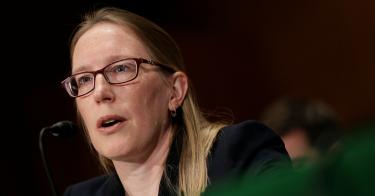At the Cato Institute FinTech Unbound Conference, Securities and Exchange Commissioner Hester Peirce gave one of the best speeches any regulator has given since the 2008 financial crisis. Peirce, nicknamed CryptoMom for her supportive stance on regulating cryptocurrencies, eviscerated the current approach to regulating financial markets.
The speech is exhibit A on how government regulators should approach their task. It provides a clear explanation of why the current approach exists, and why it is so difficult to change. It also clarifies why the current regulatory framework, very much like the well-intentioned helicopter parent, hovering over every move a child makes to ensure success, is destined to fail. Peirce reasons:
We know we will be blamed when something goes wrong, and this fear leads to a default suspicion of risk-taking and a regulatory mindset that too often presumes that innovations designed to provide greater access to risk-taking are threats, both to our reputations and investor safety. Better, we naturally think, not to allow the investor to leave the house, even for a quick trip down the street, unless properly helmeted, swaddled in regulation protective gear, and strapped into a vaguely European-branded car seat that is secured exactly in the center of the back seat of the largest SUV that an upper-middle class professional’s salary can buy. And thus we convince ourselves that nothing can go wrong…
The current system too often assigns regulators the task of deciding which investments should be undertaken and who can invest. The term investor protection used to refer to protecting investors from fraud, the perfectly sensible role for a government regulator. Now, the term is practically synonymous with ensuring investors never lose money, and that is counterproductive. As Peirce clarifies:
The problem with such an approach, of course, is that something will go wrong. Something always goes wrong. Companies fail. Fraudsters cheat. Nature strikes. Market downturns happen.
But the losses of prohibiting risk-taking are also real. Even when we cannot readily measure them (or even because we often cannot measure them), these losses are potentially very threatening to investor welfare.
Nobody has the necessary knowledge to prevent all future mistakes, and trying to do so via government regulation is foolish precisely because it prevents too many people from learning from their mistakes. As Peirce explains, this hyper-paternalistic approach makes even less sense coming from the SEC:
It puzzles me that it is so difficult for those of us who regulate the securities markets to understand this concept; after all, capital markets are all about taking risk, and queasiness around risk-taking is particularly inapt. A key purpose of financial markets is to permit investors to take risks, commensurate with their own risk appetites and circumstances, to earn returns on their investments. They commit their capital to projects with uncertain outcomes in the hope that there will be a return on their capital investment. The SEC, as regulator of the capital markets, therefore should appreciate the connection between risk and return and resist the urge to coddle the American investor.
Indeed. Just like parents preparing their children to be strong, well-functioning members of society, regulators should ensure that investors have access to the information they need to make good decisions based on their own appetites for risk. They simply have to let them go and let them succeed or fail.
Coddling investors, instead, ultimately exposes them to even more risk. Furthermore, hyper-coddled investors are less likely to be able to handle the consequences when things go wrong. Eventually, as is clearly happening now, regulators’ helicoptering prevents people from taking advantage of new risk-return tradeoffs.
Peirce’s speech is worth reading in its entirety. It lays out a common sense regulatory approach that would look almost nothing like the existing framework, especially in light of the post-2008 changes to financial regulation.
Thanks largely to the 2010 Dodd-Frank Act, the regulatory system is now built on macro-prudential regulations and a far-reaching mandate to stamp out financial instability. This system places governmental regulators—with their purportedly greater understanding of the financial system—at the top of the decision-making chain.
Anything that fallible human beings create is bound to fail at some point, a fact that applies to government regulators just as readily as it does to private markets. Giving certain investments the regulatory stamp of approval is also dangerous because it increases systemic risk: too many people end up too heavily invested in assets that everyone (mistakenly) thinks are safe.
While Peirce believes that regulators should not act like helicopter parents, she seems to be on something of an island.
For instance, the Trump administration has embraced the role of the Financial Stability Oversight Council, a key vessel for the helicopter-mom regulators. Last week, the administration nominated Nellie Liang, the former director of the Fed’s Office of Financial Stability, to a seat on the Federal Reserve Board of Governors.
Liang helped create the Fed’s post-crisis regulatory framework, and she openly supports the Dodd-Frank approach. In a recent paper, Liang wrote:
To address systemic risk, the government could tax or directly reduce financial “vulnerabilities,” defined as the collection of factors that contribute to the potential for widespread financial externalities. Vulnerabilities include leverage, maturity transformation without government insurance, compressed pricing of risk, interconnectedness, and complexity. [Emphasis added.]
Liang doesn’t just want the government to clamp down on known risky decisions, but also on those that regulators view as potentially risky. There is no better analogy here than a helicopter parent.
History has clearly shown that prioritizing regulators’ risk management has horrible consequences, yet even the Trump administration seems to be doubling down on the Dodd-Frank approach. Financial markets will not be safer and more resilient unless regulators let go of their helicopter instincts.
This piece originally appeared in Forbes https://www.forbes.com/sites/norbertmichel/2018/09/25/cryptomom-crushes-helicopter-regulators/#2974d73425f6



